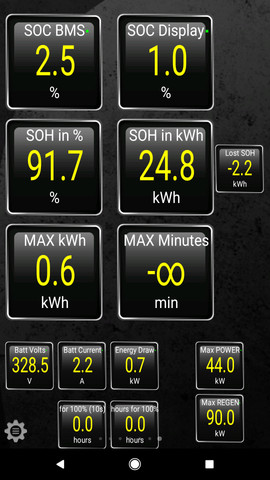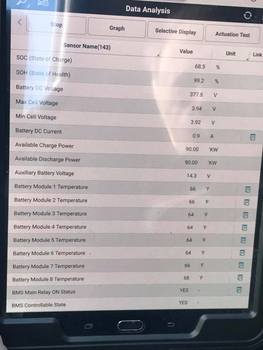SoulEV2016
Well-known member
- Joined
- Jul 18, 2016
- Messages
- 572
No news because, 1 month without use (charge every 15 days for 12h, no problem with 12v ACID battery).




Date km Avg Det Max Det Min Det Max Cell Min Cell BMS SOC CEC CED kWh/km Comments
2014-08-28 0 0.0 0.0 0.0 Assume start with 0 date of start of use
2015-09-17 10060 8.0 8.0 8.0 Bought the car, do not know the deterioration. Just a guess.
2016-01-17 18709 10.8 11.6 10.0 3 15 55.00 57.00 First readout with Torque
2016-01-27 19421 10.4 11.1 9.6
2016-01-28 19493 12.3 13.4 11.1 43 51
2016-02-01 19777 9.2 10.2 8.2
2016-02-10 20419 9.2 10.0 8.4
2016-02-20 21131 9.4 10.4 8.4
2016-03-04 22057 11.0 11.6 10.4 3 8 32.00 32.50
2016-03-07 22271 11.0 11.6 10.4 3 8 18.00 17.50
2016-03-07 22271 10.4 11.1 9.6 3 83 95.00 100.00
2016-03-11 22555 11.1 11.8 10.3 9 15 46.50 48.00
2016-03-14 22769 10.4 11.1 9.6 9 8 95.00 100.00
2016-03-21 23268 10.1 11.0 9.1 43 49 95.00 100.00
2016-03-25 23553 11.6 12.6 10.6 42 59 95.00 100.00
2016-04-01 24051 12.9 13.7 12.1 42 15 95.00 100.00
2016-04-08 24454 10.4 11.1 9.6 9 1 95.00 100.00 5062 4951 0.202461765 start measure CEC and CED
2016-04-12 24620 10.4 11.1 9.6 9 1 95.00 100.00 5088 4977
2016-04-13 24722 10.4 11.1 9.6 9 1 95.00 100.00 5105 4994
2016-04-14 24876 10.4 11.1 9.6 9 1 14.00 13.50 5108 5020
2016-04-15 24876 9.5 10.2 8.7 43 15 95.00 100.00 5132 5020
2016-04-26 25745 9.5 10.2 8.7 43 15 5284.2 5166.5
2016-05-04 26310 9.5 10.2 8.7 43 15 95.00 100.00 5377.4 5256.6
2016-05-06 26478 9.5 10.2 8.7 43 15 5.00 3.50 5382.1 5286.2
2016-05-06 26478 8.1 8.8 7.3 2 8 95.00 100.00 5408.2 5286.5
2016-05-25 27802 8.1 8.8 7.3 2 8 95.00 100.00 5620.1 5494.5
2016-05-26 27969 8.1 8.8 7.3 2 8 15.00 14.50 5623.5 5519.8
2016-05-26 27969 9.2 10.1 8.2 48 83 95.00 100.00 5646.8 5520.3
2016-05-30 28191 9.8 10.8 8.8 9 59 95.00 100.00 5682.9 5556.5
2016-06-20 30535 9.5 10.5 8.5 9 49 78.00 82.00 6073.7 5941.4
2016-07-01 31340 9.5 10.5 8.5 9 49 95.00 100.00 6207.2 6064.6 0.161719431
2016-07-12 31846 9.5 10.5 8.5 9 49 95.00 100.00 6287.1 6143.1 0.161268939
2016-07-15 32010 9.5 10.5 8.5 9 49 12.00 11.00 6291.1 6171.4
2016-07-15 32010 10.3 11.3 9.3 9 15 95.00 100.00 6315.4 6171.7 0.161553732
2016-07-25 32662 9.6 10.2 9.0 2 1 95.00 100.00 6416.9 6269.8 0.160672515
2016-09-08 35992 10.5 11.2 9.8 43 84 95.00 100.00 6882.3 6714.5 0.15284278
2016-09-16 36165 10.5 11.2 9.8 3 15 81.50 85.00 6971.9 6804.8 0.15829562
2016-09-19 36361 11.5 12.2 10.7 9 15 95.00 100.00 7012.8 6841.1 0.158738557
2016-09-21 36525 11.5 12.2 10.7 9 15 17.00 16.50 7018 6868.6 0.158860078
2016-09-21 36525 11.1 12.0 10.1 32 15 95.00 100.00 7041.1 6868.9 0.158884931
2016-09-26 36525 11.2 12.0 10.4 3 15 95.00 100.00 7086.7 6912.5 0.162496893
2016-10-03 37364 11.2 12.0 10.4 3 15 14.50 14.00 7165.8 7013.3 0.159744384
2016-10-03 37364 11.2 12.0 10.4 2 49 95.00 100.00 7189.5 7013.6 0.159767622
2016-10-21 38705 14.2 15.2 13.2 43 59 12.00 11.50 7413.2 7244.1 0.160908006
2016-10-21 38705 13.0 13.8 12.2 2 59 95.00 100.00 7437.6 7255.4 0.161700933
2016-10-27 39000 13.0 13.8 12.2 2 59 13.00 12.50 7467.4 7308 0.162037674
2016-10-27 39000 11.8 12.7 10.8 9 59 95.00 100.00 7491.3 7308.4 0.162065173
2016-11-08 39844 13.1 14.1 12.1 9 61 95.00 100.00 7647.5 7457.9 0.162891488
2016-11-09 39901 13.1 14.1 12.1 9 61 63.50 66.00 7648.7 7468.3 0.162963682
2017-01-09 43944 12.9 13.6 12.2 2 59 95.00 100.00 8441.6 8239.8 0.168742945
2017-01-31 45483 12.6 13.4 11.8 95.00 100.00 8657.3 8457.4 0.166741167
2017-02-08 46158 14.1 15.0 13.1 42 62 53.00 55.00 8873 8675 0.171581275
2017-02-20 47103 13.4 14.2 12.6 2 15 95.00 100.00 9065.3 8851.6 0.172219524
2017-03-10 48319 15.1 16.0 14.1 42 59 16.00 15.50 9266.6 9068.8 0.172545569
2017-03-11 48319 13.8 14.8 12.8 9 59 95.00 100.00 9289.7 9069.1 0.17255814
2017-04-06 49992 13.8 14.8 12.8 9 59 15.00 15.50 9559.5 9342 0.171939854
2017-04-06 49992 12.5 13.3 11.7 9 15 95.00 100.00 9582.7 9342.3 0.171951602
2017-04-24 51326 13.7 14.6 12.7 9 59 30.00 30.50 9793.5 9558.3 0.171453558
2017-05-01 51691 12.7 13.7 11.7 9 59 95.00 100.00 9882.4 9623.9 0.171564416
2017-05-30 53593 12.7 13.7 11.7 9 59 16.00 15.50 10172.3 9929 0.170836336
2017-05-30 53593 11.7 12.7 10.7 9 59 95.00 100.00 10195.4 9929.4 0.170850063
2017-06-07 54172 11.7 12.7 10.7 9 59 16.50 16.00 10273 10028.1 0.170842587
2017-06-07 54172 12.5 13.3 11.7 3 49 95.00 100.00 10296.1 10028.4 0.170852682
2017-06-14 55116 12.5 13.3 11.7 3 49 18.00 17.50 10430.7 10181.9 0.170598787
2017-06-14 55116 12.5 13.4 11.5 9 59 95.00 100.00 10453.2 10182.2 0.170608571
2017-06-27 55955 0.0 0.0 0.0 0 0 50.00 52.00 0.5 4.3 -0.15703311 OBC reset
2017-06-28 55993 14.0 15.0 13.0 2 35 95.00 100.00 19.2 10.1 0.152631579
2017-06-29 56158 14.0 15.0 13.0 2 35 15.00 14.50 22.6 36 0.156157635
2017-06-29 56158 12.2 13.0 11.4 2 15 95.00 100.00 45.9 36.6 0.1591133
2017-07-10 57163 12.2 13.0 11.4 2 15 16.50 16.00 179.1 184.4 0.149089404
2017-07-10 57163 11.4 12.6 10.2 9 49 95.00 100.00 202.2 184.7 0.149337748
2017-07-22 58337 12.1 12.8 11.3 1 59 15.50 15.00 364.1 363 0.150587741
2017-07-23 58337 10.8 11.7 9.8 9 59 95.00 100.00 387.2 363.3 0.150713686
2017-07-24 58495 11.7 12.7 10.7 9 59 95.00 100.00 411.9 388.5 0.151259843
2017-07-29 58995 11.0 12.1 9.8 9 59 95.00 100.00 488.1 463.9 0.151184211
2017-08-09 60091 14.1 14.7 13.4 9 68 17.50 17.00 633.1 628.5 0.150918762
2017-08-10 60091 11.8 12.5 11.0 2 25 95.00 100.00 655.8 628.9 0.151015474
2017-08-31 61743 12.0 12.9 11.1 3 8 18.50 18.00 890 873.7 0.150207326
2017-08-31 61743 12.6 13.3 11.8 2 61 95.00 100.00 912.5 874 0.150259157
2017-09-09 62760 14.4 15.6 13.1 3 8 18.00 17.50 1054.6 1034 0.151315209 5 days in a row below 19%
2017-09-10 62760 12.9 13.9 11.8 9 59 95.00 100.00 1077.1 1034.3 0.151359295
2017-09-11 62898 15.2 15.6 14.7 1 15 95.00 100.00 1098.3 1055.8 0.151447501
2017-09-13 63010 13.9 15.3 12.5 3 8 95.00 100.00 1117.2 1074.1 0.151637137
2017-09-14 63170 13.2 14.2 12.1 3 59 95.00 100.00 1139.2 1096.4 0.151365211
2017-10-09 65211 12.6 14.4 10.8 7 15 45.00 46.50 1455.1 1417.8 0.152711755
2017-10-16 65730 12.6 14.4 10.8 7 15 16.00 15.50 1528.6 1499.1 0.152920716
2017-10-16 65730 12.9 14.0 11.7 9 59 95.00 100.00 1551.6 1499.4 0.152951407
2017-11-03 67047 14.7 15.3 14.0 2 8 95.00 100.00 1783.3 1722.1 0.154868374
2017-11-14 67824 14.0 15.2 12.8 21 8 95.00 100.00 1921.4 1853.7 0.155817676
2017-11-15 67943 15.8 16.3 15.3 2 59 95.00 100.00 1940.3 1873.5 0.155922589
2017-11-22 68430 15.8 16.3 15.3 2 59 15.50 14.50 2007 1960.1 0.156777555
2017-11-22 68430 14.3 15.2 13.4 9 59 95.00 100.00 2030.3 1960.5 0.156809619
2017-12-02 69151 15.6 16.6 14.6 5 62 94.00 98.50 2166.3 2091.2 0.158146408
2017-12-08 69529 15.6 16.6 14.6 5 62 95.00 100.00 2236.7 2159.7 0.158788861
2017-12-15 69774 15.6 16.6 14.6 5 62 95.00 100.00 2283.9 2205.6 0.159295173
2017-12-21 70239 13.8 15.4 12.1 7 12 50.00 52.00 2355.5 2290.5 0.160053206 70.000 km

















...we present a scatter graph of the SoH versus odometer of the EVs of different year and model. You can see the wide scatter in the graph – obviously lots of other things than just age of the EV and odometer affect battery health. Flip the Fleet needs more data to test ideas about what causes this variation and to see how best to minimise battery SoH loss.

Kia played the same game as Nissan. The option to limit the charge to 80 % was removed for the 30kWh. Should we expect the same result? My own opinion is that the NZ sample size is too small, and the number of factors too great for us to make any conclusions based on this Leaf data.pushevs said:It’s not surprising that the 30 kWh versions suffer more from charge/discharge cycles, since they are more often charged to 100 %. Remember that the option to limit the charge to 80 % was present in the 24 kWh version, but was removed when the 30 kWh battery was introduced (to game EPA range ratings…).


In most European countries the limit is 150,000km, so the warranty of my car will end sometimes late next year...JejuSoul said:-
The warranty line assumes a 7 year, 160,000km limit to 70% SOH.
I think this is the norm for most countries.
The exception is the United States where the warranty is 10 years 100,000 miles.




Brian Henderson said:...my Soul EV has 35,000 miles and had 99.2% SOH (State of Health, ie: 99.2% of usable capacity vs new from factory) ...

